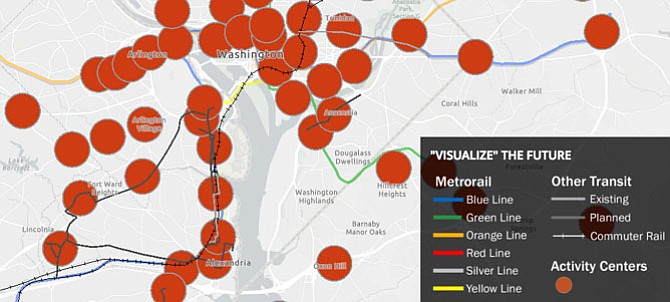New forthcoming long-range regional transit plan, seeking public input, wants to tie together transit options, housing, jobs and jurisdictional funding and political will.
Through a series of public forums, a metropolitan planning organization seeks input in formulating a new, bolder transit plan.
The organization is the federally mandated National Capital Region Transportation Planning Board (TPB), which includes representatives from 26 state and local governments, as well as Metro. TPB writes the plans that big transportation-related projects must adhere to in order to be eligible for major public dollar allocations. In this way it serves as a kind of “gatekeeper,” said John Swanson, a transportation planner with the Metropolitan Washington Council of Governments (COG), which provides TPB’s staffing.
Should a vision shrink to meet fiscal constraints, or should funding grow into fulfilling a larger vision?
TPB’s current program, called the Financially Constrained Long-Range Transportation Plan (CLRP), tends toward the former. It’s “not a wish list of projects,” but includes only “projects for which funding is ‘reasonably expected to be available’ in the future.” Visualize 2045 adds some element of the latter. In addition to some 500 funded projects of the sort in the CLRP, it’ll include 500 or more that have been planned but not yet funded, or that are “aspirational.”
“The new long-range plan has things that we want to do more of. But we need to find the funding and, frankly, we need to find the political will to make these things happen,” said Swanson. The public forums seek to put “flesh on the bones of these initiatives. … Do [residents] think that these are things that they want to see more of? Or do they have concerns about some of the initiatives, and some directions that they don’t want us to go? We’d like to really explore with the public what these things look like, what they mean, what they could mean to their futures.”
Unfunded initiatives fall under seven headings:
- Bring Jobs & Housing Closer Together: “Our region doesn’t have enough housing for our expected growth,” according to a TPB presentation. TPB identifies 141 “regional activity centers,” six of which are in Alexandria, around which it wants to see residential density increase. This approach is “efficient,” making “good use of existing infrastructure” and providing “opportunity for transit options,” said Swanson. “It’s probably the most powerful tool that we can use to reduce congestion.”
- Expand Bus Transit Regionwide: Bus rapid transit (BRT) “would provide high-quality transit services that approach the speed of rail, but at a fraction of the cost to build,” according to the presentation. “More transit would provide new travel options for scores of people who currently struggle to get to and from work.”
- Move More People on Metrorail: Projects could include expanding more trains from six to eight cars; expanding and adding Metro stations; and adding a new inner loop between the Pentagon, Georgetown and Union Station. Stations in the metropolitan core account for 80 percent of all rail destinations and transfer points, so reducing congestion there would relieve congestion everywhere, including on roadways.
- Provide More Telecommuting & Other Options for Commuting: Projects could include employer incentives for telework; increased transit and carpool subsidies; and reduced parking subsidies.
- Expand Express Highway Network: More toll lanes would encourage carpooling and bus-riding. “Express lanes would expand economic opportunity, making it easier for commuters to know with certainty that they can get to work on time on a regular basis,” according to the presentation. They’re also the “most likely” means of generating sufficient revenue for road projects.
- Improve Walk & Bike Access to Transit: Projects would improve sidewalks, lighting, crossings and trails, especially to increase accessibility to mass transit.
- Complete the National Capital Trail: Projects would add or improve 21 miles of bicycle/pedestrian trails.
Many city plans and initiatives already accord well with Visualize 2045, says Yon Lambert, Alexandria’s director of transportation & environmental services.
“Alexandria is focusing on projects such as the Potomac Yard Metrorail Station … and the West End Transitway because these projects support the city’s goals and align with regional initiatives,” he said. The city is “also committed to making investments in transportation technologies that improve road safety and traffic management.”
Councilman Tim Lovain supports “focusing development around our Metro stations and always including affordable housing in that development,” he said earlier this month. He also supports “improving pedestrian and bicycle access to our Metrorail stations.”
Vice Mayor Justin Wilson said that Visualize 2045 “requires bold thinking across the region to make the recommendations reality, but it’s important to get us thinking about what is possible.”
Find materials at www.mwcog.org/visualize2045. Public forums closest to Alexandria are on Tuesday, May 1, 7-9 p.m., at COG (777 N. Capitol St. NE, Suite 300, Washington, D.C.); and Wednesday, May 2, 6:30-8:30 p.m., at the Arlington County Central Library (1015 N. Quincy St., Arlington).
(This article was corrected May 1, 2018 to state that the TPB is a metropolitan planning organization.)
